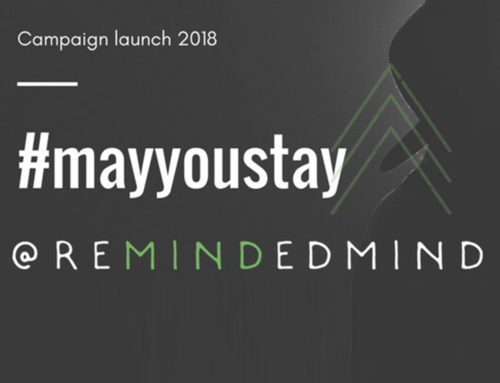13 Resources When
ReMindEd • June 18, 2017
This blog is directed at professionals. Whether that be mental health therapists, wellbeing staff, teachers, guidance officers or other professional people that find themselves working with or supporting a person through mental health concerns, specifically thoughts around suicide, or suicidal ideation as I will refer to it.
My aim is to equip you with resources and tools to actually help someone who is in need of being helped, as there can be more damage done, even by a professional, if they are ill-equipped in their responses.
This blog forms the third part in our four-part series in response to the Netflix series, 13 Reasons Why and in their extended forms, are Reminded’s May You Stay program we will be running in High Schools soon. This series and school program were birthed from our first month-long annual social media campaign, #mayyoustay which gathered momentum throughout May 2017.
1. Ensure your help is helpful
This sounds obvious, but too often, people arrive in our mind health clinic with ridiculous stories of what was said by previous professionals. I realise some of the way a client hears what is said may be squewed due to their state of mind, (which is my sixth point), but we should be so familiar with what we are saying, suggesting and offering to clients as resources, that we can guarantee it does not do more damage!
The final episode in ’13 Reasons Why’ is directed at the school counsellor/psychologist/social worker/chaplain/guidance officer/wellbeing teacher, whatever may be his actual title or qualification, as the thirteenth reason why the character Hannah completes suicide. As I have previously said in other blogs in this series, the people Hannah refers to in her tape recordings are not the reasons, but they are contributing factors. The school counsellor being one of the contributing factors is not okay! Make sure your interaction with clients is actually helpful!
2. Be familiar enough with what current pop culture is
I’m not suggesting to watch or do things that are beyond your own set of values or that could damage you. For me, I can’t watch horror films, so I don’t need to go and watch the latest paranormal movie just because clients are talking about it, nor am I suggesting you do. But I am suggesting, be familiar. Read reviews, story lines, know who the most influential celebrities are and why they are popular, watch the highlight reel or preview of the latest news or cinema release. And I mean celebrity news, more so than the world news adults may be interested in staying up to date with, particularly when working with teenagers.
When ’13 Reasons Why’ was released and became popular (the most popular Netflix series to have been released to date), aside from the topic being one very close to my heart- teenagers and suicide and school culture- my clients started referring to it. My daughters started talking about their friends talking about it. And there was lots of talk about it on social media and news programs. So I decided to watch it so I could thoroughly respond and interact with the show, it’s content and the producers’ reasons for releasing it. Now I can confidently talk about it with clients, parents, other professionals, and know what I’m talking about. I can not stand blogs and opinion pieces written by people who have not even watched it. People who often slam the writers and producers for its content- content they have not even seen and interviews with producers they have not even watched. I can not stand it! And neither can your clients!
3. Be honest
It is okay to admit that you haven’t seen something, that you don’t know who that celebrity is or why they are currently being talked about on Facebook. Don’t pretend you know what they are referring to if you don’t. Kids can see right through that, and if you fail that one test, they won’t offer you anything else. It’s a great conversation starter to ask questions about what they are into, watching or care about. So show interest. And ask about it next time to show you have listened and care.
Be honest. If you don’t know what to say next, say that. Don’t make up some floundering comment full of your own doubt and lack of confidence. Your client will not continue being honest with you.
In the show, Hannah says to the counsellor, “It literally makes no difference what you are saying”, after he quickly loses her with his own discomfort, lack of skill and lack of confidence. If a client learns they can’t talk to a professional, who else do you think they have to talk to?
4. Don’t make assumptions
This one is really important, as it’s possibly the thing Mr. Porter does the most in his conversation with Hannah and the reason he loses her completely. Here’s the transcript of some of their conversation from Episode 13:
Mr Porter (P): I’m glad to see you Hannah.
Hannah (H): Glad?
P: yes, glad to see your name on my calendar. What’s on your heart today?
H: everything I guess.
P: (phone rings- distracted) Ok, everything huh? Everything is a lot. Let’s start with how you feel right now.
H: Right now?
P: yeah right now.
H: lost, I guess. Sort of empty.
P: Empty?
H: Yeah. I don’t feel anything. I don’t care anymore.
P: Hmmm. You don’t care about what?
H: anything. School. Myself. People here. My parents.
P: Your parents?
H: I mean, I care about them. I’m just not who they need me to be.
P: who do they need you to be?
H: Not a problem.
P: How are you a problem to them?
H: I don’t know. (Phone rings) You can get that if you want.
P: no. Listen. What about your friends? Do you care about them?
H: what friends?
P: Nah, I know you have friends. I’ve seen you in the halls…(names three ‘friends’)
H: They’re not my friends…they hate me…it’s like it doesn’t even matter what you say…maybe it does.
P: I’m not following. (Hannah gets up to leave room). Wait…okay, when you leave this office, how would you like things to be different for Hannah?
H: I don’t know. I’m not sure what I’m expecting.
P: it sounds like there’s something you need that you’re not getting.
H: I need it to stop.
P: what to stop?
H: (cries) Everything to stop. Just people. Life.
P: Life? (Pushes tissue box over towards her) Hannah, what did you mean when you say you needed life to stop?
H: I don’t know.
P: it’s a very serious thing to say…
H: I know, sorry. I didn’t mean that, I guess…
P: (cutting her off) What happened? How did you get here?
H: One thing on top of another.
P: if I’m going to help you, you need to be more specific. (Phone rings)
…
P: What happened at the party? Was there… did you… have an encounter at the party?
H: Encounter? Yeah you could say that.
P: Did… (large pause)
H: You don’t want to talk about this do you?
P: No, I do. I’m not going to judge you. Did anything happen that night that you regret?
h: yes
p: was it embarrassing? Did you make a decision with a boy you regret?
H: oh my god, no! That’s just what you assume?
P: no I’m just asking
H: decision- no. I didn’t make any decision. (Phone rings)
P: Fid anything happen at the party that is illegal?
H: maybe
P: alcohol?
H: yeah but I wasn’t drinking
P: drugs?
H: I don’t think so
P: did he force himself on you?
H: I think so
P: You think so? But you’re not sure? Did you tell him to stop?
H: No
P: Maybe you consented and you changed your mind?
H: no, it’s not like that
…
Mr Porter goes on to ask her for details and the name of the offender, which Hannah doesn’t tell him.
P: Well if you can’t give me a name and you don’t want to press charges, there’s only one other option. Move on.
H: Do nothing?
P: if he is a senior, he’ll be gone in a few months.
H: Are you f..@&ing kidding me?… Yeah, just what I’ll have to do then. Thankyou Mr Porter… I need to get on with things, right… (Hannah leaves)
I know that was long, but I wanted you to see where Mr Porter makes some fundamental mistakes and misses opportunities to ask questions, instead making assumptions. It can be easy to do but please don’t do it!
5. Hear what they are saying and know what they are trying to say
It’s really hard for anyone to put emotions, thoughts and feelings into words. This is particularly true for kids and teens. Try telling someone you hardly know how you feel! It’s tough. Ensure you honour their bravery in even coming in at all, by acknowledging how brave they are and how hard it is to put words around the content of our minds.
You need to hear them. Hear what they are saying. If you’re not sure what they mean, ask them. Have creative ways to explore feelings and thoughts rather than only relying on words. Metaphors and word pictures are great for this. I use metaphor all the time- with adults too. It helps us make sense of something that is hard to make sense of. Have lots to choose from so you can find something in any situation. I’ll do another blog on this specifically in the future.
Once you’ve been involved in therapy for some years, you’ll get a sense of what people may be trying to say. Offer these suggestions in the form of a question, checking whether this word or this metaphor could be used to help describe that particular thing to you. Again, don’t assume.
In the final episode of the show, Hannah meets with Mr. Porter. She describes it as, “One last try at life”, in seeking help. She speaks about wanting to talk about “everything on my heart”, realising she “can’t do it alone”. But what she is met with is a distracted, inexperienced, underskilled teacher who was more interested in the phone that kept ringing than he was in listening to Hannah. Mr. Porter missed what Hannah was trying to say. He also missed what she was saying.
At one point Hannah said, “I need it to stop. I need everything to stop. People, life”. Mr. Porter missed the opportunity to ask Hannah if she was thinking of suicide, to offer to her the distinction between wanting to die and wanting all the pain to stop; that there are other ways to end pain than dying. He missed a completely open door into providing clarity to Hannah around her suicidal ideation. Helping clients make this distinction is so important, as they often realise they don’t actually want to die, they just don’t know there are alternatives to ease what is happening in their life. Give them alternatives. Give them hope.
6. Let hope rise
One of the main things present in suicidal people is hopelessness. Once we lose hope for the future, even for our own tomorrow, death seems like the obvious choice to end pain, ease suffering, cease confusion, and be in control of our mind and our life. When tomorrow is likely to be the same or worse than today, why would anyone want to stay to face it?! We need to teach people to find hope, to know they will get through this, that things can and do change for the better, that it will not always feel like this, that there is hope for things to change for the better. But if they are not here, they won’t be here to see it change. The possibility of things becoming better needs to be stronger and more likely than things remaining the same or getting worse.
And that’s our job: to promote hope by offering something real. It’s not a word or a concept, it needs to be something. Practical strategies: things they can do right now to shift things in their mind; to help them cope better with the load; to ease some of their suffering. That’s our goal. Give them something now because you may not get another chance. Mr. Porter didn’t get that de one follow-up session. Make the most of the one you do have. Let hope rise and despair sink.
7. The depth of the water is irrelevant when you know how to swim

I love this saying, not just because I wrote it. It’s so true. It came to me when I was running beside the ocean one morning. I was watching a surfer, so confident in his ability in deep water because he was confident in his ability to swim. The depth of the water was therefore irrelevant.
In the same way, clients need to build resilience, to be confident in their ability to get through even the deepest of waters. Teach them how to swim better.
Hannah says in Episode 7, “When you’re drowning and no one will throw you a line, you reach for anything”. Give them solid things to reach for. Real, practical things that work. If you don’t have a whole ‘toolbox’ of these practical strategies to draw upon, don’t work with another suicidal client until you do! I’ll give you some examples in another blog post.
8. Be aware of the way a client may hear what you are saying
As I referred to in the beginning of this blog, clients who are suicidality are often in an altered state of mind and can hear things differently to your intended meaning. This is actually really common. Particularly when there’s another mental health diagnosis alongside the suicidation, which there often is. It is not the client’s job to hear what you are trying to say. It’s yours. You need to be well prepared in how what you’re saying could be heard. This takes practice, experience, but mostly discernment and intuition. It’s a gift more than a skill, but can be learned to work well enough. Again, check in with clients as to what they hard you say or thought you meant, ask rhetorical questions, say the same thing in many different ways, use written material they can take and read later, use metaphors and word pictures or ask them to give you a word picture of what they think you are saying. Listen to the way they respond after you say something. If they go off on a different tangent, they probably heard that rather than what you meant.
Be open to the process. You are not the expert on their mind: they are. If they go a different direction, or hear something different to your intended meaning, go with it. It may take you somewhere else they need to go more than where you were wanting to take them. You can always note your point down and revisit it later, or in a different way. Allow the client to set the pace. They may not yet be ready to hear what you meant, may be resistant to that truth or path, or may disagree. They are entitled to all of those. Let them take the steps they are ready to take.
But do take responsibility for what you are saying. The point in therapy is what the client hears not what you say.
9. Build therapeautic trust
There are all the obvious ways to do this: listen, be responsive, use rhetorical questions, ask questions, check in how they are going, use calm and consistent body language, be engaged, be present, be respectful, be non-judgmental, be safe. I say these are obvious, but be intentional about these being part of your processes every time. Don’t get complacent or lazy. Every time. Mr. Porter was completely distracted, agitated, uncomfortable and made assumptions in Hannah’s session. He lost her completely. And he was her last hope. Never underestimate what it takes for clients to come to therapy sessions. It is a BIG deal. Every time.
So ensure you are a safe person, be kind, be consistent, be present. Ensure the room is private, quiet, with minimal distractions for yourself. Trust is the only thing that will keep the client seeking your help and they may not try someone else if you fail them in this area.
10. No one is just looking for attention
It’s sad I need to put this one here. But so many young people report that previous adults or professionals or teachers or parents have not taken their help seeking seriously. There still exists a perpetuating belief that people talk about suicide as attention seeking rather than a serious or concerning threat. They don’t. Every single cry for help is a cry for help and should be treated as such. Even the boy who cried wolf eventually cried wolf due to one being there. Assume the wolf is real, so that, if it is at some point, they will be heard when they cry wolf again. And that time, it’ll matter! Every time matters.
And even if someone does say something for attention, they therefore need attention. So give them attention. It’s better to look for the wolf than ignore it.
11. Teach them to fight the wolf
I had to keep going with this metaphor. If someone is calling wolf, the wolf’s existence is irrelevant. You have an opportunity to teach that person how to fight the wolf. That way, whether currently there or not, if it ever is, they will know how to fight back and will not be eaten. The wolf can’t win. His howling is loud enough. He is there even if he can’t be seen. He can appear to anyone, at anytime. He is no respector of persons. Everyone needs to train to fight him, to understand their own mind, to know how to deal with negative thoughts, with battles of their mind, with overwhelming emotions and hurtful things that happen. Because the wolf can come at any time!
12. Go after them
The final moment of Hannah’s conversation with Mr. Porter is her leaving his office. She walks about ten steps down the hall and turns back towards his door, hoping he follows after her. She says, “His door is closed behind me…He’s not coming. I think I made myself clear. No one is coming forward to stop me”. He doesn’t go after her. She then goes home and kills herself. And I say it that bluntly as it is factual. I’m not blaming him, but he did contribute to her death by his lack of response.
Go after them. Don’t give up on them. Ensure you can say, at the end of a session, “I did all I could for that client”. Mr Porter could not say that. Ensure you can regardless of the outcome.
13. Each single life is valuable
I’d assume, as professionals, we understand and agree with this statement. But does it show in our practice? Too often clients talk about previous help seeking where the professional is rushed, distracted, watching their clocks, or that they feel like a number. This is not okay.
Each single person is a life. A valuable, important life. Even if you’re tired and it’s the sixth session of the day on a Friday, this life in front of you matters as much as the life of the first client on a Monday morning. They need to feel that.
Care looks like something. Love looks like something. Care enough. You may be the only person who does!
In the final episode Hannah says, “Some of you care. None of you cared enough. And neither do I”.
Care enough.
—————-
Sally has been working for more than 15 years in the mental health field across schools, community agencies and in private practice. Her passion is teaching people to be more consciously in control of their minds and dealing with subconscious beliefs and trauma responses and protective mechanisms of the mind. In doing so, she has walked thousands of clients through suicidality, addictions, mental health illness, psychosis and personality disorders.
She provides professional supervision, training and workshops to professionals, students and clients throughout Australia on location, through phone or Skype or from her mind health clinic: Reminded, in Coolum Beach in QLD. Sally works alongside her husband of fifteen years, Grant, and they have four children aged from thirteen to five.
Our annual month-long campaign #mayyoustay ran throughout May raising awareness for living, and responding to the show with reasons to stay.
www.reminded.com.au
www.reminded.com.au/blog
@remindedmind @RemindedMind





